 Traveling Exhibitions
Traveling Exhibitions Traveling Works of Art
Traveling Works of Art Conservation Projects
Conservation Projects Excavations
Excavations Fellows
Fellows Exchanges & Collaborations
Exchanges & Collaborations Multiple Items
Multiple Items
The Met Around the World presents the Met’s work via the global scope of its collection and as it extends across the nation and the world through a variety of domestic and international initiatives and programs, including exhibitions, excavations, fellowships, professional exchanges, conservation projects, and traveling works of art.
The Met Around the World is designed and maintained by the Office of the Director.
Traveling
Exhibitions
The Met organizes large and small exhibitions that travel beyond the Museum's walls, extending our scholarship to institutions across the world. See our national and international traveling exhibition program from 2009 to the present.
Traveling
Works of Art
The Met lends works of art to exhibitions and institutions worldwide to expose its collection to the broadest possible audience. See our current national and international loans program.
Conservation
Projects
The preservation of works of art is a fundamental part of the Met's mission. Our work in this area includes treating works of art from other collections. See our national and international conservation activities from 2009 to the present.
Excavations
The Met has conducted excavations for over 100 years in direct partnership with source countries at some of the most important archaeological sites in the world. Today we continue this tradition in order to gain greater understanding of our ancient collections. See our national and international excavation program from the Met's founding to the present.
Fellows
The Met hosts students, scholars, and museum professionals so that they can learn from our staff and pursue independent research in the context of the Met's exceptional resources and facilities. See the activities of our current national and international fellows.
Exchanges & Collaborations
The Met's work takes many forms, from participation in exchange programs at partnering institutions and worldwide symposia to advising on a range of museum issues. These activities contribute to our commitment to advancing the work of the larger, global community of art museums. See our national and international exchange program and other collaborations from 2009 to the present.
 Scene in a niche of the same corridor depicting Nefertari offering to the goddess Hathor (T1042). Photograph by Harry Burton, 1921–22. Archives of the Egyptian Expedition, Department of Egyptian Art.
Scene in a niche of the same corridor depicting Nefertari offering to the goddess Hathor (T1042). Photograph by Harry Burton, 1921–22. Archives of the Egyptian Expedition, Department of Egyptian Art.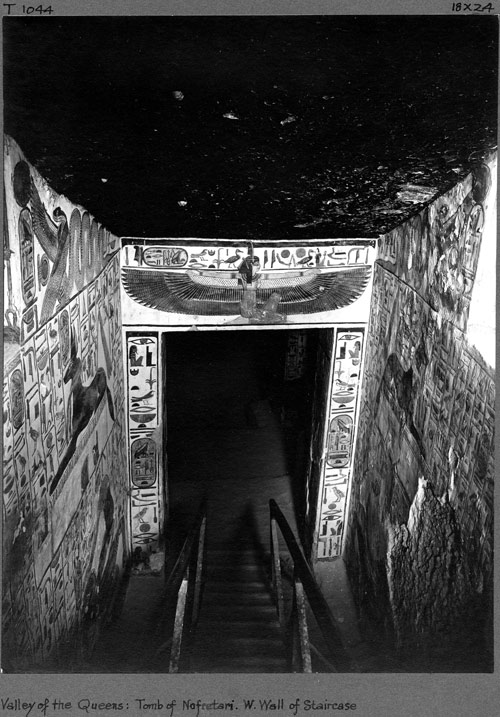 Descending corridor leading to the burial chamber in the tomb of Queen Nefertari (T1044). Photograph by Harry Burton, 1921–22. Archives of the Egyptian Expedition, Department of Egyptian Art.
Descending corridor leading to the burial chamber in the tomb of Queen Nefertari (T1044). Photograph by Harry Burton, 1921–22. Archives of the Egyptian Expedition, Department of Egyptian Art. "Basket L" and its contents; tomb of Hatnofer and Ramose (M16C 180–183; 233, 234, 236–239). Photographs by Harry Burton, 1936. Archives of the Egyptian Expedition, Department of Egyptian Art.
"Basket L" and its contents; tomb of Hatnofer and Ramose (M16C 180–183; 233, 234, 236–239). Photographs by Harry Burton, 1936. Archives of the Egyptian Expedition, Department of Egyptian Art.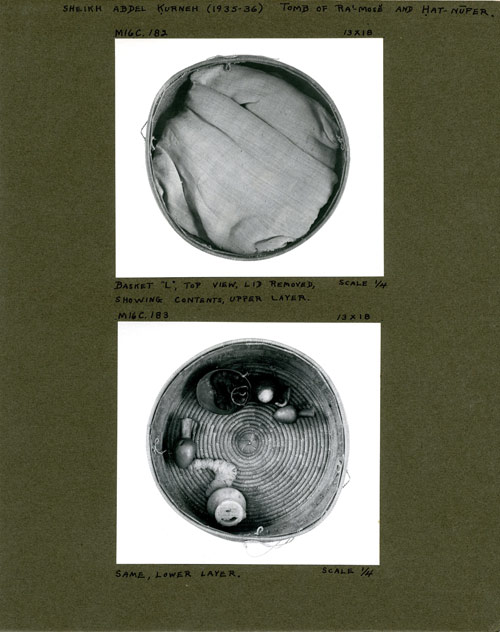 "Basket L" and its contents; tomb of Hatnofer and Ramose (M16C 180–183; 233, 234, 236–239). Photographs by Harry Burton, 1936. Archives of the Egyptian Expedition, Department of Egyptian Art.
"Basket L" and its contents; tomb of Hatnofer and Ramose (M16C 180–183; 233, 234, 236–239). Photographs by Harry Burton, 1936. Archives of the Egyptian Expedition, Department of Egyptian Art.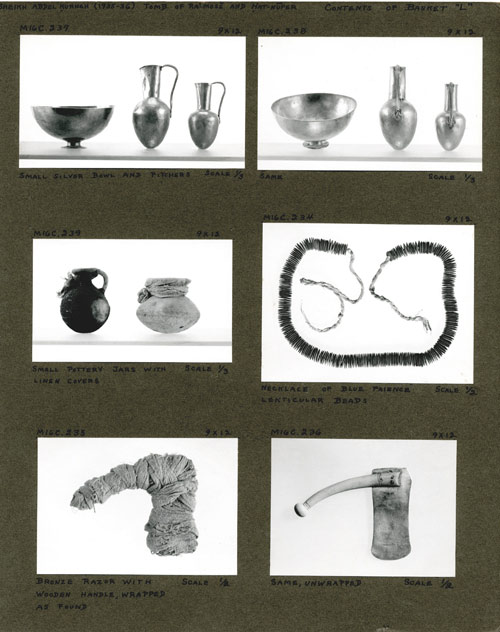 "Basket L" and its contents; tomb of Hatnofer and Ramose (M16C 180–183; 233, 234, 236–239). Photographs by Harry Burton, 1936. Archives of the Egyptian Expedition, Department of Egyptian Art.
"Basket L" and its contents; tomb of Hatnofer and Ramose (M16C 180–183; 233, 234, 236–239). Photographs by Harry Burton, 1936. Archives of the Egyptian Expedition, Department of Egyptian Art.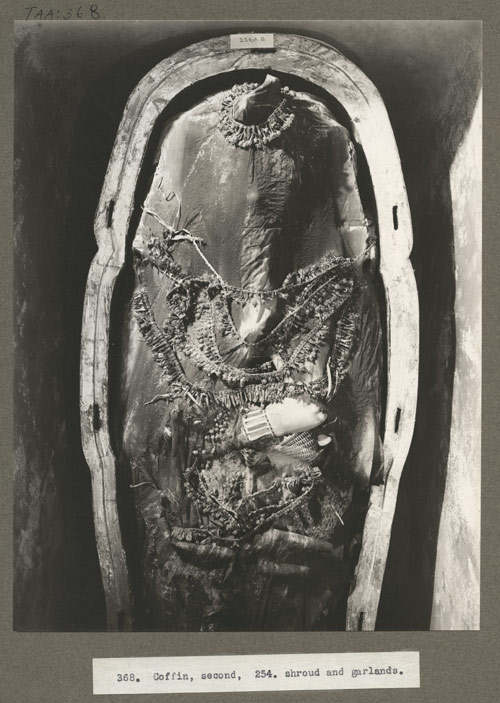 Tutankhamun's second coffin (TAA 368). Photograph by Harry Burton, 1925. Archives of the Egyptian Expedition, Department of Egyptian Art.
Tutankhamun's second coffin (TAA 368). Photograph by Harry Burton, 1925. Archives of the Egyptian Expedition, Department of Egyptian Art.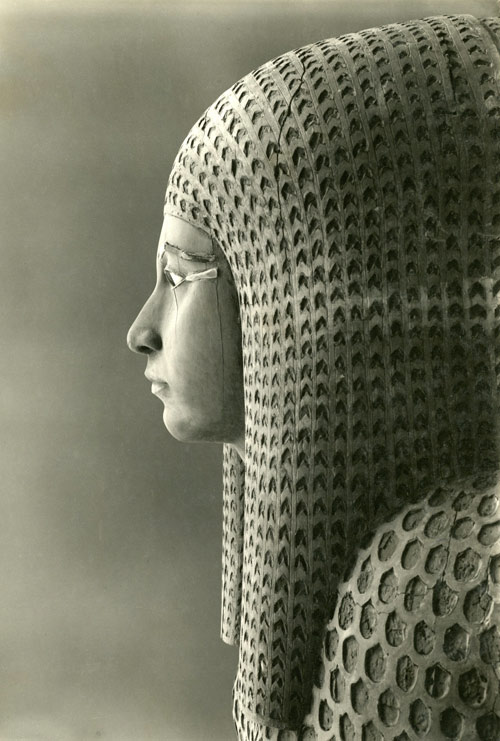 Outer coffin of Queen Merytamun (M10C 119). Photograph by Harry Burton, 1929. Archives of the Egyptian Expedition, Department of Egyptian Art.
Outer coffin of Queen Merytamun (M10C 119). Photograph by Harry Burton, 1929. Archives of the Egyptian Expedition, Department of Egyptian Art.
Egypt
1914–1936
During more than thirty years, he made a systematic photographic record of some 100 Theban tombs. A few of these were royal tombs in the Valleys of the Kings and Queens, but most were small offering chapels of officials, with their scenes of daily life. Except for the deepest of the royal tombs, which required electric lamps, Burton found the most effective way to light tomb interiors was the local technique of reflecting sunlight with mirrors. He also developed a camera mount that allowed him to take the photographs in each tomb at the same distance from the walls, and thus at the same scale.
Originally hired to document tomb paintings, Burton quickly became the official photographer for the Theban excavations as well. He photographed the landscape before and after excavation, documented work in progress, and took record photographs of the objects being uncovered. He was also a brilliant storyteller, using photographs to convey the atmosphere of a tomb unseen for thousands of years; the poignancy of a wreath left as a parting gift; the anticipation inspired by a sealed door. He also brought a sense of artistry to his work that created images of haunting beauty and mystery.
Burton's photographs illustrate the yearly excavation updates that were published in the Museum Bulletins. They were also used in numerous scholarly publications by Metropolitan Museum Egyptologist Herbert E. Winlock and his colleagues, and in the series of Theban tomb publications produced by Norman de Garis Davies for the Graphic Section. His clear, informative images gained Burton a reputation as the finest archaeological photographer of his time. It is not surprising that, when Tutankhamun's tomb was discovered in 1922, Howard Carter contacted Albert M. Lythgoe, Director of the Museum's excavations, and requested Burton's assistance. The request was immediately approved and Burton spent the next decade dividing his time among the Museum's Theban excavations, the Graphic Section, and the documentation of Tutankhamun's tomb.


